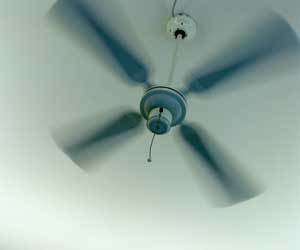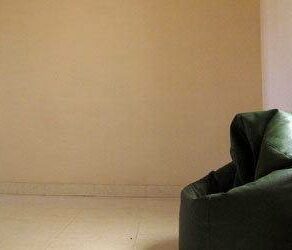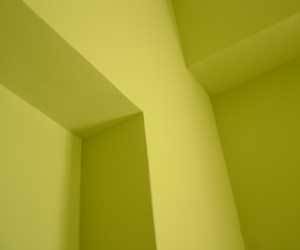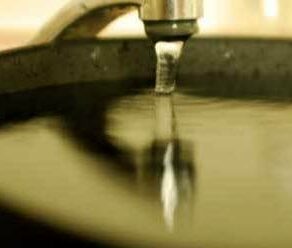Ceiling  stains are not only unattractive, but can signify hidden damage beyond the surface. Get to the bottom of your ceiling woes by following this easy guide to determine what kind of stain you have and how to get rid of it — for good. If you don’t have any stains, give the ceiling a general cleaning to freshen it.
stains are not only unattractive, but can signify hidden damage beyond the surface. Get to the bottom of your ceiling woes by following this easy guide to determine what kind of stain you have and how to get rid of it — for good. If you don’t have any stains, give the ceiling a general cleaning to freshen it.
General Cleaning
To clean your ceiling, a mix of one part white vinegar in two parts water can be used. Test it first on a small hidden area to look for any adverse reaction. An alternative to using the vinegar solution is to use an all-purpose cleaner. The ceiling can be cleaned by hand working in small sections. Spray the solution onto a cloth or sponge and wipe the area. Another method is to use a mop and simply mop the ceiling. Flat wet mops work well for this. There are some that can be purchased with a sprayer attached, but it would be best not to use the sprayer for the ceiling as it will mist onto everything below, including you. Instead, spray the cleaner onto the mop head, then wipe using the mop. Be careful not to scratch the ceiling with the corner of the mop or any other sharp edges that may be on it.
Determining the Type of Stain
Most ceiling stains result from one of two causes: water damage or smoke. It is quite easy to tell the two apart. Water stains are recognizable by a yellow or brownish stain which will often appear in a circular or radiant pattern. Smoke damage, on the other hand, is characterized by a dingy yellow, fine gray or charcoal color. Because soot consists in part of tiny ash particles, it may smear or otherwise worsen when you try to wipe it off.
Removing Water Stains
Before attempting to remove water stains from a ceiling, make sure that the source of the water stain has been repaired. Check for damage to the roof or leaks in nearby plumbing. If you are unable to find the cause, call a professional. Once the leak has been fixed, you can get rid of the stain.
You Will Need:
- Plastic drop cloth
- Step ladder or sturdy furniture
- Safety glasses
- Rubber gloves
- Fan or ventilation
- Bleach (if mold is present)
- Soft cloth (for bleach if needed)
- Water
- Paint roller and brush
- Roller pan
- A thick, general purpose primer such as KILZ
- Paint to match your ceiling
The Cleaning Process:
- Start by removing furniture from the floor under the area to be painted.
- Spread a plastic drop cloth under the stain and the surrounding area to prevent splatter damage from bleach or paint.
- ALWAYS WEAR APPROVED SAFETY GLASSES when working overhead, especially with the use of chemicals!
- USE PROTECTIVE GLOVES when working with bleach or other chemicals.
- Examine the stained area for mold. If you see anything that looks fuzzy or resembles mold, make a solution of one part bleach and one part water and blot the area carefully to kill mold or mildew. Allow the area to dry completely before continuing.
- Prime the area with your stain killing primer. Use a roller paint brush for a smooth finish.
- Allow the primer to dry completely.
- Finish the job with a coat of paint that matches the rest of the ceiling, using a clean roller brush. Add a second coat if necessary.
Cleaning Smoke Stains
Smoke stains can take on the appearance of a dingy yellow tint. These are distinguishable from water stains in that the darkened ring-like edge does not appear as it often does with water damage. With more direct exposure to flame, soot deposits adhere to the ceiling, leaving gray or black residue.
You Will Need:
- Stiff brush
- Plastic drop cloth
- Step ladder or sturdy furniture
- Safety glasses
- Rubber gloves
- Fan for ventilation
- Trisodium-Phosphate (TSP) -available at most paint, hardware and home improvement stores
- Warm water
- Sponges (for TSP solution and rinsing)
- A thick, stainblocker/sealer such as KILZ
- Paint roller and brush
- Roller pan
- Paint to match your ceiling
The Cleaning Process:
- Start by removing furniture from the floor under the area to be cleaned.
- Spread a plastic drop cloth under the stain and the surrounding area to prevent splatter damage from chemicals or paint.
- ALWAYS WEAR APPROVED SAFETY GLASSES when working overhead, especially with the use of chemicals!
- USE PROTECTIVE GLOVES when working with TSP or other irritants and be careful to keep it off of your skin.
- Begin by briskly brushing the smoke stain with a stiff brush. Be sure to remove all loose material.
- Mix a solution of ¼ cup TSP with one gallon of very warm water. Apply to the stain with a sponge as many times as necessary to thoroughly remove any remaining residue.
- Rinse the area well with a clean sponge and warm water until all of the TSP solution has been removed. Allow to dry completely.
- Once the area has dried, prime the spot with your sealer. Use a paint roller brush for best results.
- Allow the primer to dry completely.
- Use a clean roller brush to paint the surface to match the rest of the ceiling. Apply a second coat if necessary.
Additional Tips and Advice
- Be sure to properly ventilate the room when using paint or chemicals indoors. Read all labels for product safety precautions.
- Use plastic — rather than cloth – for a drop cloth. Paint, bleach, and other chemicals will quickly soak through fabric, possibly ruining what is underneath.
- Don’t skip the stain-killing primer application. It does not matter how many coats of paint you apply – the stain will continue to bleed through if you don’t properly follow this important step!
- You may find that you’ll need to paint the whole ceiling to match the new paint on the refinished spot. Be ready for that possibility, especially when the ceiling hasn’t been painted in a while or if you can’t match the paint.









I got Miesek lemon oil spatters on my walls. I need to know what can be used to get it off, so that it does not have to be painted.
I have an acoustic ceiling in my pizzeria, made of light-weight molded mineral fiber with a mat surface finish having a spongy quality. Charcoal soot has deposited on the ceiling- it seems to have an oily base. How do I clean the soot without destroying the tile surface and cracking the tiles?
Does this work on popcorn-style ceilings that have never been painted?